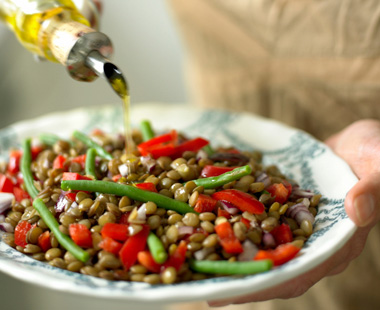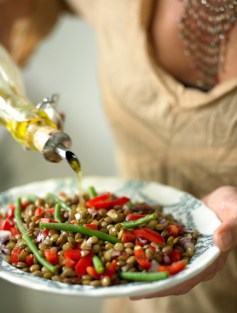This post is part of Protein Angst, a series on the environmental and nutritional complexities of high-protein foods. Our goal is to publish a range of perspectives on these very heated topics. Add your feedback and story suggestions here.

Vegetarians are out of luck again ...
In his 2000 bestseller Kitchen Confidential, Anthony Bourdain swatted down vegetarians on behalf of the foodie elite:
Vegetarians, and their Hezbollah-like splinter faction, the vegans, are a persistent irritant to any chef worth a damn. To me, life without veal stock, pork fat, sausage, organ meat, demi-glace, or even stinky cheese is a life not worth living. Vegetarians are the enemy of everything good and decent in the human spirit, and an affront to all I stand for, the pure enjoyment of food.
A lot has changed in the last decade. Now all the hot new chefs, and most of the big-name old-timers too, preach the gospel of local, seasonal, and sustainable. They flaunt their friendships with the organic farmers in their foodsheds. Their menus are paeans to the small-scale and the artisanal.
But one thing hasn’t changed: Vegetarians still get no respect.
These days, sustainably raised meat is the star of most hip restaurants’ menus. Don’t want to eat any meat? Then you get to content yourself with afterthought sides or wan pasta — if they haven’t been spiked with meat too.
As I took pains to clarify in my last post on vegetarianism, I wholeheartedly support the shift to more ethical and eco-friendly meat production. But a key component of conscientious omnivorism is eating meat sparingly. Why is it that chefs who claim to get sustainability don’t get this one simple fact?
If you care about a healthy food system and environment, your menu should include meat-free options — not just for vegetarians and vegans, but for the many other people who are eating less meat these days. And you need to offer not just side dishes, but at least one thoughtful and delectable meat-free entrée — with protein. Dare I even dream of two?
Far too often, the popular new bistros and gastropubs springing up in foodie enclaves around the country don’t have a single damn main dish I can eat. I live in Seattle, supposedly a mecca for sustainable food (just ask Frank Bruni), and I can’t enjoy a decent meal at most of the talked-about restaurants in town.
For example, consider award-winning, locavore-leaning chef Ethan Stowell. The fact that one of his four Seattle restaurants is named How to Cook a Wolf offers your first clue that vegetarians won’t be warmly embraced. There aren’t any actual wolves on his menus, but other meats are sprinkled liberally around, even on dishes you might think would be suitable for a vegetarian: tuna on the potato gnocchi and the soft-boiled eggs, anchovies on the beet salad and the spaghetti.
Same tune at Sitka & Spruce, the beloved outpost of another celebrated, sustainability-embracing Seattle chef, Matthew Dillon. Even the mushrooms are off-limits. On one recent day, the chanterelles were sautéed with liver pâté; on another, the hedgehog mushrooms were cooked up with grilled calf’s liver.
At the stylish new RN74, Michael Mina’s addition to the Seattle scene, it’s no surprise that the entrees are all meat-centric; unfortunately, the vegetables are too. The kale, for example, is lovingly procured from local Carpinto Brothers Farms — and then cooked up with ham hock.
Or consider a recent menu at the beautiful Book Bindery restaurant, where chef Shaun McCrain has been winning rave reviews. On a quick skim, I’m delighted to see both white beans and lentils — until I discover that the white beans are just a bed for clams and chorizo, and the lentils are just a bed for chicken. For a moment I think I can turn to the pasta: “Hand-Made Smoked Cavatelli” with foraged mushrooms, pickled pearl onions, English peas, and — d’oh — foie gras emulsion. Never mind. Even the “Autumn Apples” starter is a no-go as this most local of fruits comes wrapped in prosciutto.
I could go on and on, taking you on an extensive tour of Seattle’s culinary highlights, and then the rest of the country’s, eating salad and bread all along the way.
When these hotspots do offer a veg-friendly entrée, more often than not it lacks protein — a risotto or pasta dish peppered with whatever vegetables happen to be hanging around. One can ask for the meat to be withheld from some dishes — but that too often means the flavor is withheld as well, as so many chefs lazily rely on pork or pâté to add the punch.
A chimpanzee could make bacon appealing. But, chefs, I offer you this challenge: What magic can you work with chickpeas? (This is a particularly relevant question for chefs in my hometown considering that Washington state is the No. 1 producer of chickpeas in the nation.) With lentils? With quinoa? With beans? And without animal products?
You say you care about sustainability? Prove it. Add to your menu a vegetarian entrée so appealing that even omnivores won’t be able to resist. I dare you. And I can’t wait to come taste the results.
—–
Vegetarians, check out the blog Un-Granola for reviews of higher-end restaurants from a veg perspective.
Also, I want to give a shout-out to two renowned Seattle chefs who treat vegetarians well. Jerry Traunfeld, formerly of the legendary Herbfarm, offers creative, delicious vegetarian thalis at Poppy. And Maria Hines has flavorful, delightful vegetarian offerings at Golden Beetle, and vegetarian tasting menus and vegan menus at Tilth. Thank you!




